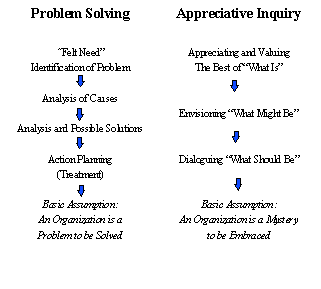
What
is Appreciative Inquiry?
extracts of papers by David L. Cooperrider, Case Western Reserve University and Diana Whitney, The Taos Institute
Appreciative
Inquiry (AI)
begins an adventure. The urge and call to adventure has been sounded by many
people and many organizations, and it will take many more to fully explore the
vast vistas that are now appearing on the horizon. But even in the first steps,
what is being sensed is an exciting direction in our language and theories of
change—an invitation, as some have declared, to
“a positive revolution”.
The
words just quoted are strong and,
unfortunately, they are not ours. But the more we replay, for example, the
high-wire moments of our several years of work at GTE, the more we find
ourselves asking the very same kinds of questions the people of GTE asked their
senior executives: “Are you really ready for the momentum that is being
generated? This is igniting a grassroots movement…it is
creating an organization in full voice, a center stage for the positive
revolutionaries!”
Tom
White, President of what was then called GTE Telops (making up 80% of GTE’s
67,000 employees) replies back, with no hesitation: “Yes, and what I see in
this meeting are zealots, people with a mission and passion for creating the new
GTE. Count me in, I’m your number one recruit, number one zealot”.
People cheer.
Enthusiasms continue, and they echo over subsequent months as lots of hard work pays off. Fourteen months later --based on significant and measurable changes in stock prices, morale survey measures, quality/customer relations, union-management relations, etc.-- GTE’s whole system change initiative is given professional recognition by the American Society for Training and Development. It wins the 1997 ASTD award for best organization change program in the country. Appreciative inquiry is cited as the “backbone”.

AI has
been described by observers in a myriad of ways: as a paradigm
of conscious evolution geared for the realities of the new century (Hubbard,
1998); as a methodology that takes the idea of the social
construction of reality to its positive extreme-- especially with its
emphasis on metaphor and narrative, relational ways of knowing, on language, and
on its potential as a source of generative theory (Gergen, 1994); as the most
important advance in action research
in the past decade (Bushe, 1995); as offspring and “heir” to Maslow’s
vision of a positive social science
(Chin, 1998; Curran, 1991); as a powerful second generation OD practice (French and Bell, 1995; Porras, 1991; Mirvis, 1988/89); as model of a much needed participatory
science, a “new yoga of
inquiry” (Harman, 1990); as a radically affirmative approach to change which
completely lets go of problem-based management and in so doing vitally
transforms strategic planning, survey methods, culture change, merger
integration methods, approaches to TQM, measurement
systems, sociotechnical systems, etc. (White, 1996);
and lastly, as OD’s philosopher’s
stone (Head & Sorenson, et. al 1996). Indeed it is difficult to sum up
the whole of AI—as a philosophy of knowing, a normative stance, a methodology
for managing change, and as an approach to leadership and human development.
However, for purposes here, it might be most useful to begin with a
practice-oriented definition of AI, one that is more descriptive than
theoretical and one that provides a compass for the examples to follow:
Appreciative
Inquiry is about the co-evolutionary search for the best in people, their
organizations, and the relevant world around them. In its broadest focus, it involves systematic discovery of
what gives “life” to a living system when it is most alive, most effective,
and most constructively capable in economic, ecological, and human terms.
AI involves, in a central way, the art and practice of asking questions
that strengthen a system’s capacity to apprehend, anticipate, and heighten
positive potential. It centrally
involves the mobilization of inquiry through the crafting of the
“unconditional positive question” often-involving hundreds or sometimes
thousands of people. In AI, the arduous task of intervention gives way to the
speed of imagination and innovation; instead of negation, criticism, and
spiraling diagnosis, there is discovery, dream, and design.
AI seeks, fundamentally, to build a constructive union between a whole
people and the massive entirety of what people talk about as past and present
capacities: achievements, assets,
unexplored potentials, innovations, strengths, elevated thoughts, opportunities,
benchmarks, high point moments, lived values, traditions, strategic
competencies, stories, expressions of wisdom, insights into the deeper corporate
spirit or soul, and visions of valued and possible futures. Taking all of
these together as a gestalt, AI deliberately, in everything it does, seeks to
work from accounts of this “positive change core”—and it assumes that
every living system has many untapped and rich and inspiring accounts of the
positive. Link the energy of this
core directly to any change agenda and changes never thought possible are
suddenly and democratically mobilized.
The positive core of organizational life,
we submit, is one of the greatest and largely unrecognized resources in the
field of change management today. As said earlier, we are clearly in our infancy
when it comes to tools for working with it, talking about it, and designing our
systems in synergistic alignment with it. But one thing is evident and clear as
we reflect on the most important things we have learned with AI: human
systems grow in the direction of what they persistently ask questions about and
this propensity is strongest and most sustainable when the means and ends of
inquiry are positively correlated. The
single most prolific thing a group can do if its aims are to liberate the human
spirit and consciously construct a better future is to make the positive change
core the common and explicit property of all.